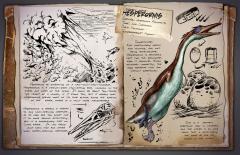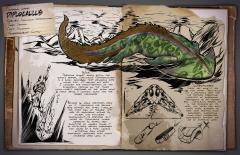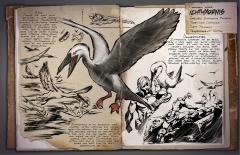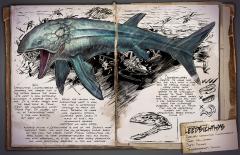Search the Community
Showing results for tags 'piscivore'.
-
-
- piscivore
- combat dino
-
(and 2 more)
Tagged with:
-
COMMON NAME: Nyctosaurus SPECIES: N. anemosilectus TIME: Late Cretaceous DIET: Piscivore TEMPERAMENT: Neutral WILD: Few creatures are more striking to behold than Nyctosaurus anemosilectus. This semiaquatic pterosaur can sometimes be found roosting atop any of the tall spires rising from this ark's multitude of tropical islands. Although normally docile unless provoked, Nyctosaurus does not like being disturbed while roosting and will attack anything that does so. This can be avoided by approaching under the cover of a ghillie suit, but be careful because it will still attack if the survivor approaches with a mount! This can make a roosting Nyctosaurus quite difficult to reach, but feeding it fish meat can earn its trust. DOMESTICATED: Nyctosaurus' saddle is a large sail fastened to its L-shaped crest and a surfboard-like platform strapped to its back, transforming the creature into some kind of living sailboard. Using its beak like a rudder and its wings to make tight drifting turns, a saddled Nyctosaurus is the most efficient means of travel across the water's surface. Although the sail, when unfurled, impedes Nyctosaurus' ability to fly, the saddle can be switched to “furled mode” where the sail is folded up against the crest. This enables the pterosaur to freely fly and dive. The crest also functions like a lightening rod, absorbing electrical shocks and rendering both mount and rider immune to attacks from the ocean's bioelectric denizens. ARTIST'S NOTES: I've been sitting on this idea for a LONG time, having actually forgotten about it after a point until something recently jogged my memory of it—just in time for this contest! It seems like most submissions to these contests are mid- to late-game tames with sometimes complicated taming methods and even more complicated abilities. For once it'd be nice to get a simple early- to mid-game tame with one or two straight-forward but incredibly fun abilities. The inspiration behind this was the debate as to whether or not the L-shaped crests of Nyctosaurus and kin supported membranes. Depictions of sailed nyctosaurs reminded me of sailboards, and that's when the bulb lit in my brain. Honestly, how cool would this be? Let's get this crazy idea into the game!
- 47 replies
-
- pterosaur
- semiaquatic
- (and 8 more)
-
-
- piscivore
- electrical
-
(and 3 more)
Tagged with:
-
From the album: Dossiers
Common Name: Hesperornis Species: Hesperornis Avenatantes Time: Late Cretaceous Diet: Piscivore Temperament: Flippant Wild: Appearing as something of a half-duck-half-dinosaur, Hesperornis is a medium-sized fish-eating bird, common in the rivers and lakes os the island. It would be about two-thirds the height of a human, if it stood tall, but it rarely does. Hesperornis spends most of its time gliding along the surface of the water, where it is much more maneuverable. Hesperornis is barely a threat to any land-dwelling creature, as its legs are too short for it to move around effectively, but it is a surprisingly fast on the water. It can easily hunt down fish and other small water-dwelling creatures. Domesticated: Not particularly useful for hunting, and not being affectionate, Hesperornis is primarily kept for the specialized eggs it produces. When rendered correctly, the eggs separate into two distinct substances: One is a protein substance high in calories, and the other is an oily liquid that is effectively the same as the oil found in the ocean!- 1 comment
-
- hesperornis
- flippant
-
(and 6 more)
Tagged with:
-
From the album: Dossiers
Common Name: Baryonyx Species: Baryonyx Aquafulgur Time: Early Cretatceous Diet: Piscivore Temperament: Passive to land creatures, but aggressive to water-dwellers Wild: Like the Carnotaurus, Baryonyx Aquafulgur is one of the smaller end of the tier of large predators. While not as powerful as some deep sea predators or Spinosaurus, Baryonyx is an extremely fast swimmer who is still nimble enough to threaten most creatures on the island. And yet despite being a fast, dangerous dinosaur, Baryonyx almost exclusively eats fish & other water-dwellers. The highly specific metabolism of Baryonyx seems to allow it to heal wounds almost preternaturally fast after feeding on nutritious fish meat. Perhaps this is why Baryonyx rarely attacks land animals? Domesticated: Baryonyx's natural affinity for aquatic predation means that once tamed, it learns to kill ocean-dwellers more efficiently. Between its speed and its power, Baryonyx makes an ideal choice for anyone interested in frequently moving between water and land travel with ease, and valuing speend and agility over raw strength. -
From the album: Dossiers
Common Name: Kairuku Species: Kairuku waitaki Time: Late Paleogene Diet: Piscivore Temperament: Friendly Wild: Kairuku Waitaki is an amazingly docile and friendly creature, to everything but fish. Honestly, I'm not quite sure how Kairuku manages to stay populated across the islands colder climates, with the many predators stalking these frozen lands. It is weak, and only one small defensive trait: suspended in Kairuku blubber are small, dense particles that act as a light form of armor. Adding to Kairuku's problems, a clever survivor discovered that refining Kairuku blubber (concentrating the particles in it) can yield a natural form of the same Polymer utilized in advanced tribes' manufacturing processes. This has caused many tribes to hunt Kairuku extensively, a practice colloquially known as "Kairu Clubbing". Domesticated: There is no reason to tame Kairuku for combat since they are useless in a fight. Still, Kairuku are regularly tamed for their cuteness and friendly nature, and the fact that their bodies run extremely hot. Just standing near Kairuku can help keep a survivor stay warm through long, harsh nights on the icebergs.-
- penguin clubbing
- organic polymer
- (and 10 more)
-
From the album: Dossiers
Common Name: Diplocaulus Species: Diplocaulus Natatorinutrix Time: Permian Diet: Piscivore Temperament: Skittish Wild: Presiding almost solely within island's swamps, Diplocaulus Natatorinutrix is a small amphibian that primarily eats minor fish. It rounds out what I consider the middle-bottom of the ecosystem, feeding on the tinier non-insect creatures of the island while itself being a common snack for the larger carnivores. Because so many creatures prey on it, Diplocaulus has become very skittish and often flees at the first sign of trouble. It uses its amphibious nature to escape into whichever environment its predator isn't native to. Diplocaulus unique capability to retain vast quantities of oxygen allows to effectively remain submerged for hours at a time, usually outlasting even other amphibious creatures that might otherwise prey upon it. Domesticated: There are only a few uses for tamed Diplocaulus. It is primarily used for the (rather disgusting) practice of employing Diplocaulus as an oxygen bag. Diplocaulus stores air in the bladders of its head, and divers can suck from these bladders to take deep breaths while submerged, supporting long-term underwater exploration without the use of external gear.-
- diplocaulus
- water
-
(and 7 more)
Tagged with:
-
From the album: Dossiers
Common Name: Ichthyornis Species: Ichthyornis piscoquus Time: Late Cretaceous Diet: Piscivore Temperament: Skittish Wild: Among the most vocal creatures on the island, Ichthyornis Piscoquus is actually a relatively normal seagull. Living near the beaches, it primarily eats fish, and its distinctive cries can be heard echoing over literally every beach across the island. As you might expect from a seagull, Ichthyornis will flee at the slightest provocation. Ichthyornis is an excellent fish hunter, often catching and killing small-to-medium fish in one attack. Its primary method of predation is to dive into the top layers of water and impale or bite its prey. When looking for fish,Ichthyornis will often just fly in circles over the water and wait for its next opportunity to dine. Domesticated: Ichthyornis surprised me by being a very loyal and social creature, once tamed. It likes to ride on its owner's shoulder, and bring that person treats (in the form of fish, of course) which its beak-grip enhances with extra healing vitamins. The personality of Ichthyornis reminds me of a housecat hauling a dead lizard back to its family, except bringing extra-healthy fish instead.-
- ichthyornis
- bird
- (and 7 more)
-
From the album: Dossiers
Common Name: Leedsichthys Species: Leedsichthys Conviviumbrosia Time: Mid-Jurassic Diet: Piscivore Temperament: Defensive Wild: Leedsichthys Conviviumbrosia is probably the largest fish in the waters around the island. Its meant is also extremely succulent, a surprise given its size. It is often traded with the same value as Prime Meat, and colloquially called ‘Prime Fish’. Of course, not all of Leedsichthys’ meat is this high quality but most of it is! While the demand for Leedsichthys meat is high, the fish is notoriously difficult to track and hunt. Between its large size, powerful attacks, incredible speed (when it turns to flee), and humankind’s general ineptitude on open water, actually killing a Leedsichthys is one of the island’s more difficult tasks. The hunt for an extremely elusive breed of the fish, the fabled ‘Great Albino’ Leedsichthys has been known to drive otherwise-sensible men and women mad with obsession, as if all evil were visibly personified and made practically assailable in this one creature. Domesticated: Despite its large size, and the fact that it may well be strong enough to carry heavy loads, Leedsichthys does not appear to be intelligent enough to tame. Nevertheless, some large tribes keep an enormous pen with a few Leedsichthys trapped inside for cultivating purposes, as bits of prime fish can be repeatedly scraped off the gargantuan beast without killing it.-
- leedsichthys
- fish
- (and 7 more)






